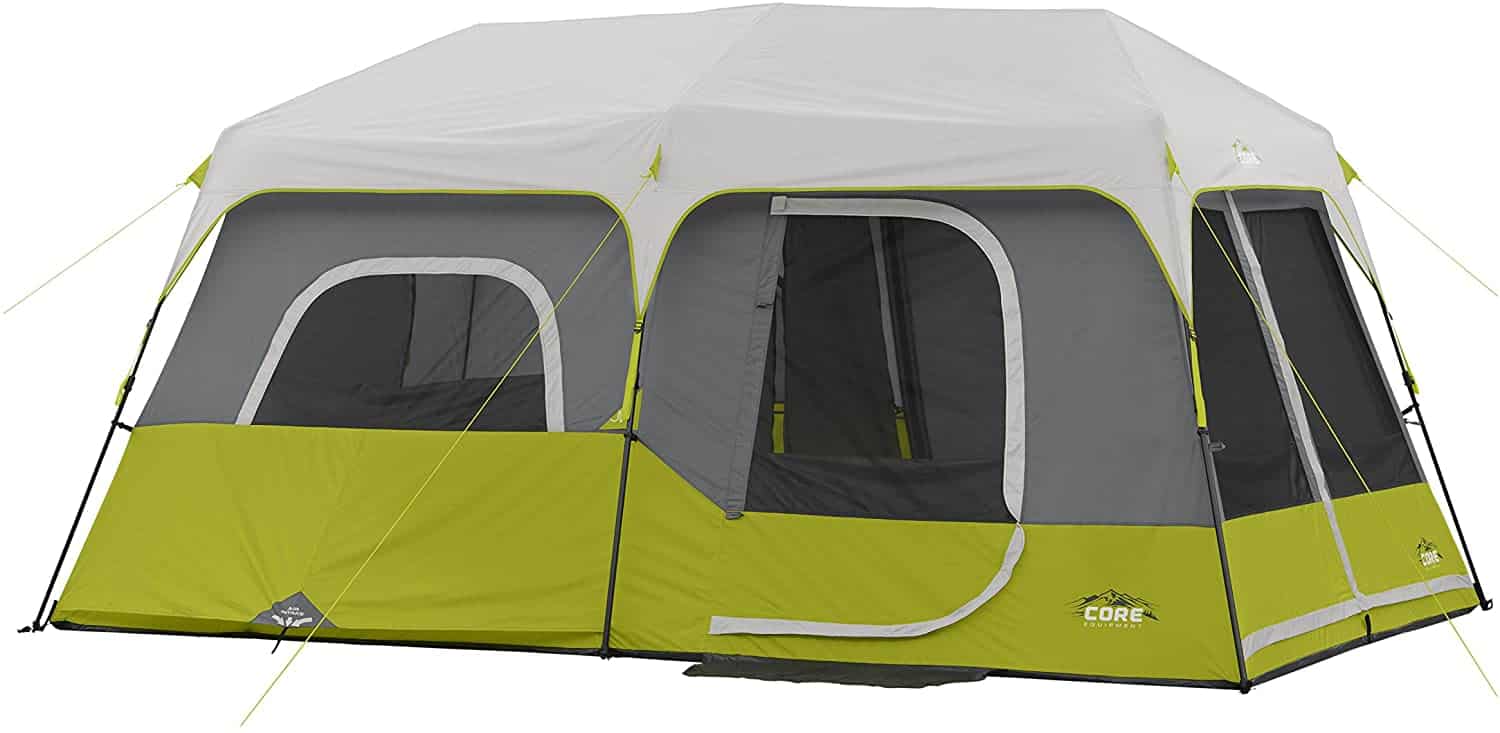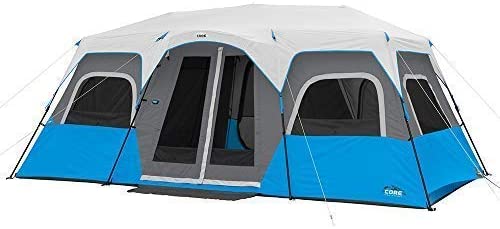Camping is a fantastic way to experience the great outdoors. However, setting up a tent can be a bit of a pain.
Thankfully, Core Equipment has many different pop-up tents that make it easy to pitch your shelter for the night so you can maximize your time in the mountains.
To help you out, this guide is complete with reviews of the best models available today. We’ll even answer some of your top questions so you can find the best home away from home for your next camping adventure.
What Is A Pop Up Tent?
A pop up tent is a type of camping shelter that can be pitched in just a few seconds. These tents usually have pre-attached poles. This substantially reduces the amount of time you have to spend pitching your tent at night.
Instant shelters are quickly gaining popularity because they simplify the tent pitching process. They come in a variety of different shapes and sizes, so they’re great for individuals and groups, alike.
Are Pop Up Tents Good For Camping?
Instant tents are, indeed, good for camping, particularly in nice weather. But, due to their design, they’re not always the best choice for really wet and rainy conditions.
Pop up shelters really shine when it comes to overall comfort and convenience. They tend to be quite spacious and will often have removable room dividers that allow you to create separate living and sleeping spaces.
However, the poles on instant tents usually aren’t strong enough to withstand really high winds. Additionally, many of them don’t have full rainfly coverage so there’s no guarantee that they’ll keep you dry in a big storm.
That being said, if your main goal is to go out for a weekend of camping with the family, they’re still a good option. Just remember that pop up camping tents are best used when the weather is nice. If the forecast is looking good for your tip, then an instant shelter is a solid choice.
How Do You Put A Pop Up Tent Together?
The main reason that people buy pop up tents is that they’re simple to set up. In fact, putting together one of these shelters usually takes just a few seconds. Here’s what you need to do:
- Find a good campsite. Look for a flat area that’s free of sharp rocks, sticks, and other debris that could rip your tent. Be sure that you’re not camping under a cliff that’s prone to rockfall or any overhanging dead trees.
- Take the tent out of the bag and place it on the ground.
- Unfold the shelter and orient it so the door is facing an ideal direction.
- Stake out the corners of the tent using the included pegs and guylines. Ensure that the shelter is properly tensioned so it won’t blow away in the wind.
CORE POP-UP TENTS THAT WE LIKE
#1 – CORE Instant Cabin 9
The Core Instant Cabin 9 is a pop up tent with a classic design. It can be set up in just 60 seconds, thanks to its pre-attached poles and it can even be pitched without the rainfly for panoramic views on clear nights.
The tent has an advanced venting system that allows for plenty of airflow on hot summer days. It has large mesh windows and a sizeable double door that can be boarded up with zippered privacy panels when needed.
Inside, the tent is very spacious and even has an included room divider so everyone can get the personal space they need. Finally, the Core Instant Cabin 9 has plenty of gear storage options, including mesh pockets, for staying organized on the go.
pros
- Can be converted into a two room tent
- Sets up in just 60 seconds
- Can be set up without roof for panoramic views
- Lots of airflow
cons
- Not fully waterproof
- Durability concerns in very windy conditions
For a fully-featured pop up tent with the latest in camping technology, it’s hard to beat the Core Lighted Instant Cabin 12. This tent has a spacious interior that can easily fit three queen-size air beds or 12 campers in sleeping bags.
It has a 6.6 foot (2m) ceiling height that offers plenty of head room for everyone in your family. Moreover, it has multiple large mesh windows that provide ample ventilation on muggy days to keep the inside of the tent cool and comfortable.
The best part about this shelter? It has a built-in LED lighting system that can illuminate the entire interior with just the push of a button. This makes it a great place to hang out as a family and enjoy some quality time together when you’re outside.
pros
- Built-in LED lighting
- High ceiling height and spacious interior
- Great ventilation
- Removable fly for panoramic views
cons
- No room dividers
- Very heavy
- Expensive
#3 – CORE Instant Dome 4
The CORE Instant Dome 4 is an affordable pop up shelter option for small families and groups. It can be set up in under 30 seconds due to its pre-attached pole design. The tent has a seam-taped rainfly that can be removed in good weather to expose the mesh ceiling for added airflow.
Additionally, this dome-style tent has an advanced air intake ventilation system that helps to draw in cool air and push out the heat. This provides added comfort on hot, sunny days, for a better all-around camping experience.
Although the tent has large windows and doors to maximize its breathability, it also has zippered panels for privacy. Plus, it has an included gear loft, mesh pockets, and lantern hook to help you stay organized while camping.
pros
- Very quick to set up
- Large windows with privacy panels for added ventilation
- Plenty of gear storage options
- Affordable
cons
- Low ceiling height (4.5ft/1.4m)
- Not fully waterproof
How To Choose A Great Pop Up Tent
Choosing a great pop up tent can be tricky, since there are so many excellent models available on the market today. So, when shopping around, keep the following key factors in mind:
Intended Use
What you intend to use your tent for will greatly affect the type of shelter that you buy. For example, someone that primarily enjoys weekend camping trips with the family will have different needs from a camper that prefers to head out on longer backpacking adventures in the mountains.
So, before you start looking at tents, take some time to think about what features are most important to you. For some campers, interior space and comfort are critical. Meanwhile, others prefer to prioritize weight savings and a compact packed size for use on backpacking trips.
Tent shape
Modern tents come in a variety of different shapes. Here are some of the advantages and disadvantages of the various camping shelter shapes:
- Dome. Dome-style tents are, as the name suggests, shaped like a dome. These shelters generally don’t provide a lot of headspace when compared to other options. But, they are very robust in the wind and rain, so they’re a great choice for backpacking.
- Cabin. Cabin tents are a fan-favorite among families and large groups because they offer a lot of interior space. One of the key benefits of a cabin-style shelter is that it has a high ceiling height, which makes it more comfortable to walk around in. Plus, this style of shelter often has multiple rooms for added privacy.
- Tunnel. This type of shelter is shaped like a long caterpillar or tunnel. They are preferred by backpackers because they tend to be lightweight, but highly durable in foul weather. However, tunnel tents often feel a bit cramped, so they’re not ideal for car camping.
Sleeping capacity
The sleeping capacity for a tent refers to the number of people that can sleep inside. As you can imagine, the size of the shelter you need will directly correlate with the number of people you tend to go camping with.
However, we recommend getting a tent that’s just slightly larger than what you actually need, particularly if you’re car camping. This will allow you to have more space inside the shelter for storing gear and for stretching out at night.
Weight
The weight of your shelter can greatly affect how easy it is to transport. A lighter tent is easier to carry from the car to the campsite, which makes it more convenient. This is particularly important for backpackers, but is still something to consider, even if you plan to sleep quite close to your vehicle.
That being said, some lightweight tents are less robust than their heavy-weight counterparts. So, it’s important to keep in mind that weight savings are often a trade-off with durability.
Packed size
Similar to weight, the packed size of a tent affects your ability to transport it. This is more of a concern for backpackers who need to fit their shelter into their pack each morning.
But, unless you have a really large vehicle, you’ll be limited with your gear storage space while car camping, too. So, a tent that packs down small is advantageous for camping.
Gear Storage
Let’s face it: camping is a gear-intensive activity. So, staying organized while you’re outside can be a challenge. Thankfully, many modern tents now come with a plethora of equipment storage options, like gear lofts, pockets, and hooks.
Keep an eye out for these features as you shop, particularly if you camp with a large family that packs a lot of gear.
Room Dividers
Many large pop up shelters have lots of interior space that can be split into smaller areas using removable room dividers. These dividers are a great added feature to any tent because they allow you to create two separate sleeping areas or a split living/sleeping space.
This is particularly helpful if you have older children that want more privacy and independence. Additionally, room dividers also make it easier to share a tent with another family, so they’re a good choice for group get-togethers.
FREQUENTLY ASKED QUESTIONS
Here are our answers to some of your top questions about instant tents:
HOW DO YOU TAKE DOWN A POP UP TENT?
Taking down a pop up tent is just about as simple as setting it up. This is what you need to do:
- Remove the tent pegs and place them in the stake bag.
- Fold up the tent so it’s just the right shape to fit in its included carry sack.
- Pack the shelter into its storage bag.
- Do a final sweep of the tent site to ensure that you haven’t accidentally left anything behind.
ARE POP UP TENTS WATERPROOF?
While there are certainly some waterproof instant tents, the majority of them aren’t truly weather-resistant. Sure, many of them are made with fully seam-taped waterproof fabrics. But most pop up models have very large windows and doors that will not keep you dry in the rain.
In a light drizzle, most pop up tents will be sufficient. But if you live somewhere that gets a lot of rain, they’re not going to be your best option.
In these situations, we recommend tents with a full-coverage rainfly. You can check out our guide to the best tents for rain and wet conditions to find the best model for your needs.
WHAT IS THE EASIEST POP UP TENT?
Most instant tents are quite simple to set up. But, CORE is known for making some really easy-to-use family-style shelters for car camping. Additionally, Quechua’s pop up models are super quick to set up on your own or with a partner during a backpacking trip.
HOW MUCH IS A POP UP TENT?
Pop up tents vary widely in price. The most affordable models sell for around $50-$100, while others with more bells and whistles will fetch upward of $400. On average, you can expect to pay around $200 for a quality pop up tent for a large family.
The Verdict
An instant camping tent is a great choice for an overnight adventure in the outdoors. When shopping around, it’s important to consider what you plan to use the shelter for and what features are most valuable to your camping experience before you commit to a specific model.
- Tint Colors Explained For Polarized Sunglasses - November 19, 2022
- Top 4 Best Portable Camping Showers of 2022 - November 19, 2022
- How to Choose Water Shoes & What to Look For - November 18, 2022







![5 Best Hammock Stands For 2021 [Buyers Guide]](https://ablecamper.com/wp-content/uploads/2020/06/20201227_160725-440x264.jpg)

